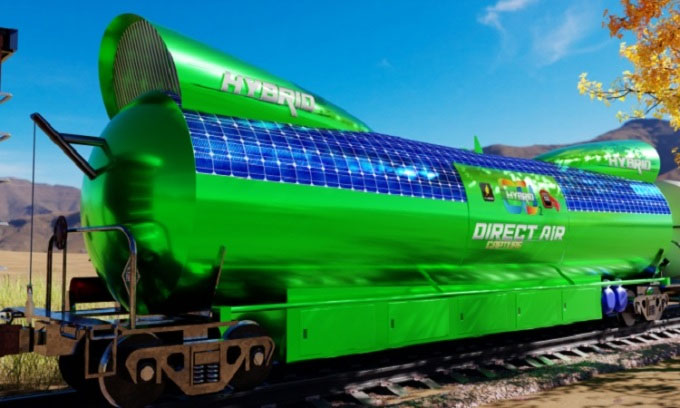The train can absorb 6,000 tons of CO2 per year

Modified train car design to capture CO2.
The team from CO2 Rail, together with the University of Toronto, developed a new method to take advantage of the existing rail network and capture CO2 from the atmosphere while passenger and freight trains move as usual. They plan to use carriages equipped with large vents to suck in air, according to a report published July 20 in the journal Joule.
Since the suction action will take place when the train is traveling at high speed, this method will eliminate the need for large fans commonly found in fixed direct CO2 capture systems, resulting in significant energy savings. The carriage also has a chamber to collect carbon dioxide (CO2), which is then concentrated and stored in a liquid tank. CO2-free air will be released into the air from the back or side of the carriage.
"Every 20 hours at the station rotating staff or refueling, the CO2 in the tank is poured into the conventional tank wagon located at that station," E.Bachman, founder of CO2 Rail, shared with Interesting Engineering. "When a large number of tank trucks are filled, a train will be created and transported up to 10,000 tons of CO2 captured to the isolation area. That is not difficult because the carriage of CO2 Rail is designed. to operate continuously for 24 hours before needing to be unloaded".
In a conventional braking system, the friction caused by the use of the brake generates heat that is released into the air. The braking action generates enough energy to power 20 houses for a day. Using regenerative braking, the train can convert this energy into electricity for direct CO2 capture. The team estimates that an average cargo ship can remove 6,000 tons of CO2 per year. With a sustainable power supply on board, the method is not only environmentally friendly, but also cost-effective. Costs are expected to be less than $60 per tonne of CO2, making the technology commercially viable.
- How the Chinese moved the 30,000-ton bus stop to make way for the new train line
- Each year, 85 thousand tons of grease, chemicals and metals are released into the sea
- It can only be Japan: The train knows how to fake dogs and deer to prevent accidents
- Dangerous that no one knows because the fault waiting for the train is not correct
- Skyscrapers can absorb 1,000 tons of CO2 per year
- Japan launches Maglev 'Speedier bullet'
- More than 6 million tons of garbage are thrown into the sea every year
- Coming soon there is faster train ... plane?
- Earth inspires' 40,000 tons of cosmic dust every year
- The train is unique pick up, pay no need to stop
- The first train powered by biodiesel
- Japan launches high-speed cushion train running 500km / h
 'Barefoot engineer' invents a pipeless pump
'Barefoot engineer' invents a pipeless pump Process of handling dead pigs due to disease
Process of handling dead pigs due to disease Radiometer
Radiometer Warp Engine: Technology brings us closer to the speed of light
Warp Engine: Technology brings us closer to the speed of light